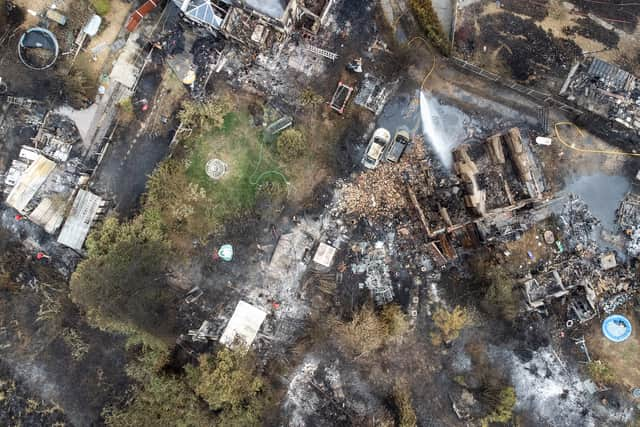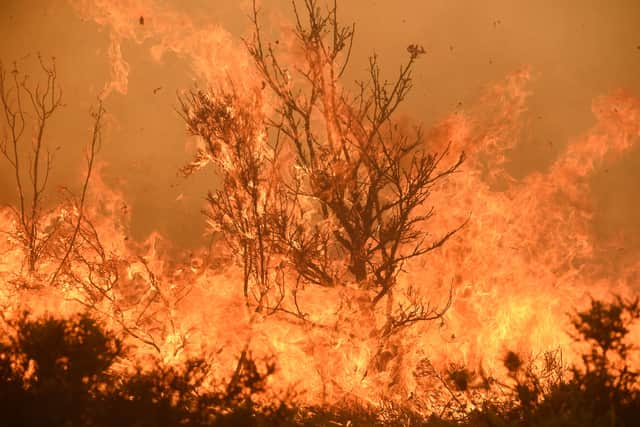London fires: How did Wennington fire start, was it a compost heap and did extreme heat start other fires?
and live on Freeview channel 276
Sixteen London Fire Brigade (LFB) firefighters suffered injuries and two were hospitalised after battling numerous blazes across the capital on the hottest day ever recorded in the United Kingdom.
The surge in fires occurred within hours of weather experts declaring for London a temperature of more than 40°C.
Advertisement
Hide AdAdvertisement
Hide AdTemperatures in excess of 40°C were recorded in St James’s Park, Kew Gardens and Northolt.
This is what we know far:


Where were the fires?
There were 10 fire engines and 70 firefighters battling a blaze on Hawthorne Avenue, Kenton and according to the London Fire Brigade it involved a “car wash, two houses and nine vehicles”.
The LFB sent 15 fire engines and approximately 100 firefighters to a village called Wennington in east London - several buildings, including homes, cars and motorcycles were completely destroyed in the blaze.
LFB firefighters also dealt with a blaze in the Wembley area - there were eight fire engines at the scene and 60 firefighters.
Advertisement
Hide AdAdvertisement
Hide AdThere was also a grass fire in Pea Lane, Upminster during which 200 people had to be evacuated from a nearby campsite - however LFB brought the blaze at the 20 hectares site under control.
Firefighters also attended a fire at Green Lanes in Southgate.
Firefighters also tackled two simultaneous grass fires in Croydon on Oaks Road and Chapel View.
Fifteen fire engines were sent to a significant blaze in the Dagenham area.
Advertisement
Hide AdAdvertisement
Hide AdEarlier in the day the LFB attended a fire at some flats in Eltham, Greenwich.
The LFB also put out a fire involving a fence, a car and a motorbike.


How did the fires start?
All of the fires have been directly linked to extreme heat visited upon London on Monday and Tuesday.
Mayor of London, Sadiq Khan, explained LFB would expect 500 emergency calls on a busy day but on Tuesday the emergency service received more than 2,600 calls.
Advertisement
Hide AdAdvertisement
Hide AdOne local resident claimed the Wennnington fire started when a compost heap “spontaneously combusted”.
“It was a compost heap, our houses back onto the marshes and it’s been like a tinderbox all week,” said 26 year-old Alfie Stock.
“It was a three-foot high pile of grass and the heat had built up inside, it just spontaneously combusted.”
Mr. Stock’s claim has not been confirmed by LFB.
Aden Shields, 54, also lived in the Wennington area and he is desperately searching for his pet dog, Daisy, who was in the property at the time of the fire.
Advertisement
Hide AdAdvertisement
Hide Ad“I have had her [Daisy] since she was a little pup. Animal welfare volunteers rang me last night, they are going to be looking for her,” said Mr. Shields.
It has been reported that almost 20 homes were destroyed in the Wennington fire.
Elsewhere, there were unconfirmed reports that some of the grass fires throughout London were started by people using disposable barbeques.
Why did the London Fire Brigade declare a major incident?
Just before 3.30pm on Tuesday afternoon the LFB started receiving reports of a small fire
Advertisement
Hide AdAdvertisement
Hide AdAssistant Commissioner for Operational Resilience and Control, Patrick Goulbourne, said: “The Brigade remains ready to respond to incidents, however we want to ensure our resources are available for people who really need our help.
“If you see a fire smouldering, please don’t hesitate to call us. The sooner we know about a fire, the sooner we can bring it under control and prevent it from spreading further, reducing the need for us to mobilise additional resources.
“We are also strongly urging people not to have barbecues or bonfires today, as the ground is incredibly dry, which means even the smallest sparks could cause a fire.
“Please take care during the heatwave as all emergency services are facing unprecedented challenges.”
Advertisement
Hide AdAdvertisement
Hide AdThere have been no reports of any fatalities but a number of people received medical treatment at the scene with several, including two firefighters requiring hospital treatment.
What advice has LFB got for the public?
- Don’t drop cigarettes or anything that is burning on dry ground.Don’t have barbecues in parks and public spaces.
- Do not barbecue on balconies, the wind may carry smouldering ash towards nearby grassland.
- Don’t dive into open water as it’s colder than it looks. There is the risk of cold water shock, which can cause your body to go into shock no matter how fit you are. It causes panic, anxiety, disorientation and loss of muscular control, which cause you to gasp for air and as a result, inhale water. Rather than struggling, follow the RNLI advice and ‘float to live’.
- In this extreme heat, please keep an eye out for vulnerable neighbours and family members and make sure to keep hydrated.
Comment Guidelines
National World encourages reader discussion on our stories. User feedback, insights and back-and-forth exchanges add a rich layer of context to reporting. Please review our Community Guidelines before commenting.
